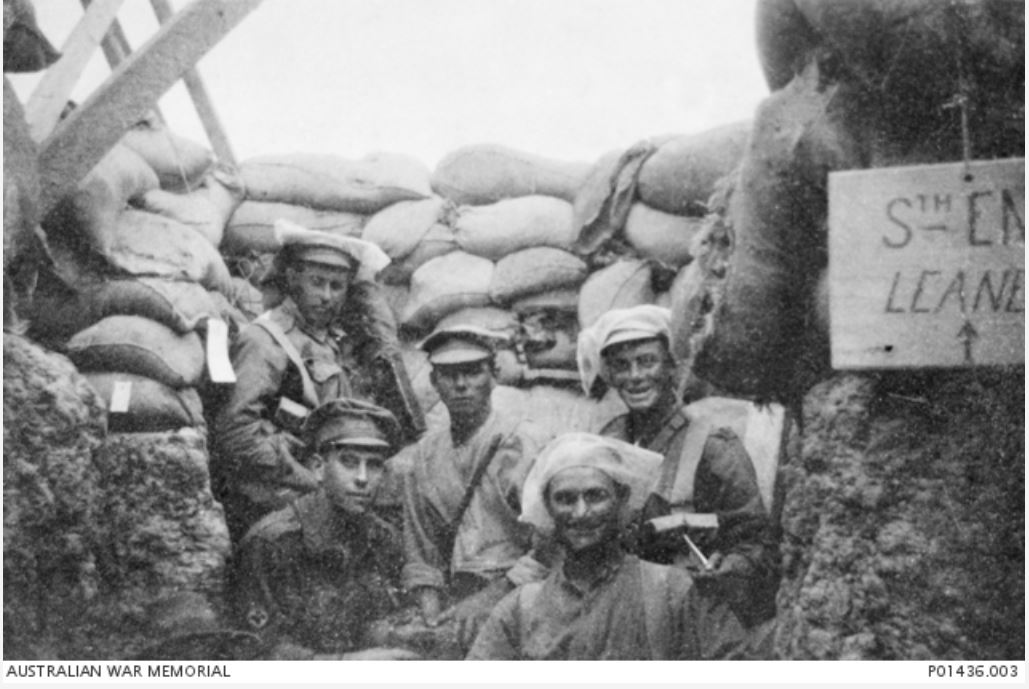12th Battalion
From Our Contribution
 Shoulder patch | |
 7 Aug 1915. Observation team at Leane's Trench. AWM photo P01436.003 | |
Contents
[hide]Brief History
The 12th Battalion was raised shortly after the outbreak of World War I as part of the Australian Imperial Force (AIF), an all-volunteer force raised for overseas service. It was raised from Tasmania, South Australia, and Western Australia. Following a brief training period, the battalion sailed aboard HMAT A2 Geelong to Egypt where it undertook four months of intensive training.
As part of the 3rd Brigade it participated in the covering force for the Gallipoli landing. After the initial landing, a stalemate developed around the beachhead and in August the Allies sought to break the deadlock by launching the August Offensive. As a part of this, the 12th contributed two companies to the diversionary attack on Lone Pine. The offensive failed, but the campaign continued and the battalion continued to serve on the Gallipoli Peninsula until early December when it was withdrawn to Lemnos Island for a rest.
In Egypt, during the reorganisation and expansion of the Australian forces, it contributed experienced men to form the nucleus of the 52nd Battalion.
After arriving in France, the 12th Battalion deployed to the Somme. The battalion's first major action in France was at Poziéres in July 1916. Later the battalion fought at Ypres, in Belgium, before returning to the Somme in winter. In 1917, the battalion returned to Belgium to take part the Third Battle of Ypres.
In 1918, the battalion helped to stop the German Spring Offensive that was launched in March and April. The battalion subsequently participated in the last Allied offensive of 1918, launched near Amiens on 8 August 1918. After Amiens, a series of advances followed as the Allies broke through the Hindenburg Line. The battalion continued operations until late September 1918 when it was withdrawn from the line for rest.
Following the end of the war members of the battalion began returning to Australia in November for demobilisation and discharge. The 12th Battalion was disbanded in 1919 having sustained casualties of 1,135 killed and 2,422 wounded.
Battalion Personnel
- † Alexander Barnett ?? Sep 1914 - 25/28 Apr 1915 (KIA Gallipoli)
- Herbert Lewis Battams 7 Jan 1916 - 1919
- Arthur Charles Cam 7 May 1915 - ?? Jun 1916
- † Stanley Joseph Callow Champion 6 Aug 1915 - 25 Jul 1916
- Arthur Clarke 15 Jun - 6 Jul 1917
- Harry Hodgson 26 May 1915 - 30 Jun 1916 - to 3rd Machine Gun Company
- Albert Stephenson Jackson 16 Jun - 7 Aug 1915 (WIA Lone Pine)
- † Elmer Winfred Drake Laing MC 10 Sep 1914 - 8 May 1918 (KIA Strazeele)
- Arthur Thomas Orton MM 26 May 1915 - 16 Apr 1916
- † Lawrence Adrian Renou DCM 12 Jul 1915 - 1 Mar 1916 - to 52nd Battalion
- Henry John Robert Saint 2 Nov 1914 - 7 Sep 1915
- Frederick Selkirk 16 Jun 1915 - 18 Apr 1916 - to 52nd Battalion
- William Stephens 10 Sep 1014 - 21 Aug 1916 (WIA Mouquet Farm)
- John Grant Watt MM & Bar 26 May 1915 - 23 Aug 1918
Battle Honours
- Anzac
- Landing at Anzac
- Defence of Anzac
- Suvla
- Sari Bair–Lone Pine
- Gallipoli 1915
- Egypt, 1915–16
- Somme 1916–18
- Poziéres
- Bullecourt
- Ypres 1917
- Menin Road
- Polygon Wood
- Broodseinde
- Poelcappelle
- Passchendaele
- Lys
- Hazebrouck
- Amiens
- Albert 1918
- Hindenburg Line
- Epéhy
- France and Flanders 1916–18
Individual Honours
- 2 Victoria Crosses (Capt James E Newland, Sgt John W Whittle)
- 1 Companion of the Order of Bath
- 2 Companion of the Order of St Michael and St George
- 5 Distinguished Service Orders, and 1 bar
- 31 Military Crosses, and 2 bars, 1 second bar
- 23 Distinguished Conduct Medals, and 1 bar
- 132 Military Medals with 16 bars and 3 second bars
- 5 Meritorious Service Medals
- 59 Mentioned in Despatches and
- 8 foreign awards
Notes
Content for the history and honours sections has come from a combination of Wikipedia and the Australian War Memorial websites. An entry in the 12th Battalion's War Diary tells which sub units transferred from the transports to Destroyers and then via small boats to the beach.
Battalion Headquarters, the Machine Gun Section and 'A' Company travelled to Gallipoli from Mudross on the SS Devahna and off the coast of Gallipoli transferred to the destroyer HMS Ribble before using its steam pinnace and ships boats to make the final approach to the beach.
'B' Company travelled from Mudross on the HMT Ionian, with 5 & 8 Platoons transferring to HMS Scourge, and 6 & 7 Platoons transferring to HMS Foxhound before again using small boats towed by steam pinnace to the beach.
'C' Company travelled from Mudross on SS Malda, with 9 & 10 Platoons transferring to HMS Colne, and 11 & 12 Platoons to HMS Beagle before again using small boats towed by steam pinnace to the beach.
'D' Company travelled from Mudross aboard HMAT 23 Suffolk with 13 & 14 Platoons transferring to HMS Chelmer and 15 & 16 Platoons to HMS USkbefore again using small boats towed by steam pinnace to the beach.[1]
- Jump up ↑ 12th Battalion War Diary - April 1915 - Appendix III
A more detailed description of this battalion's participation, see:
- The Story of the Twelth A Record of the 12th Battalion AIF during the Great War 1914-18 by L.M. Newton